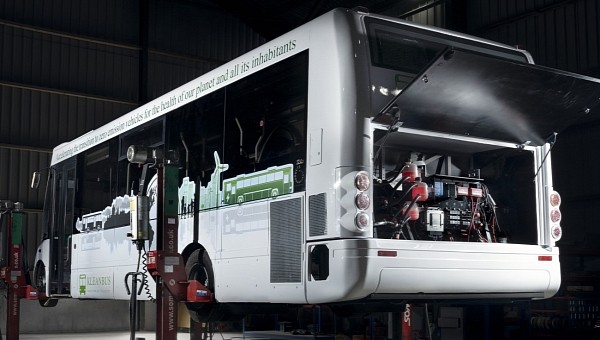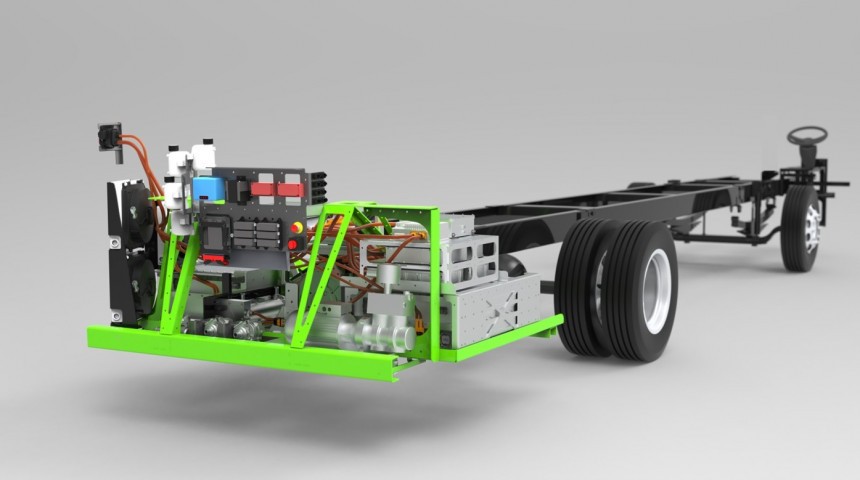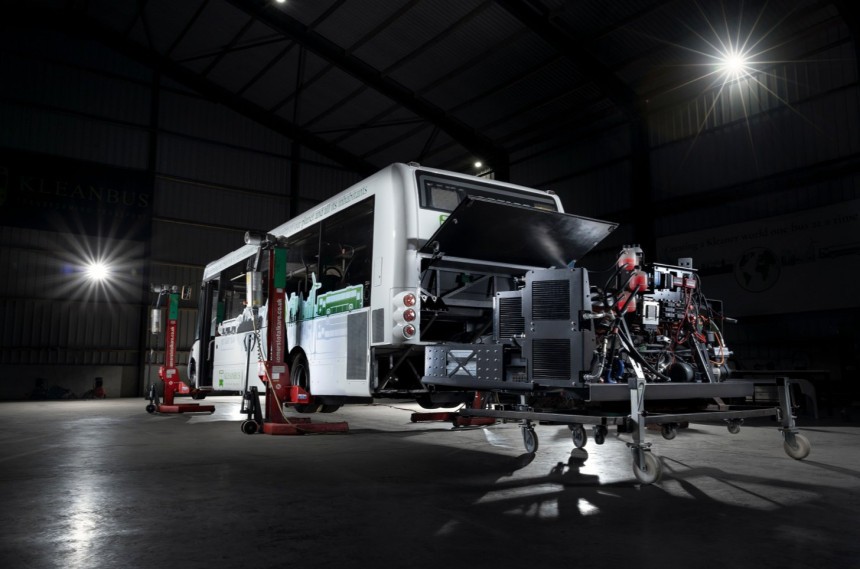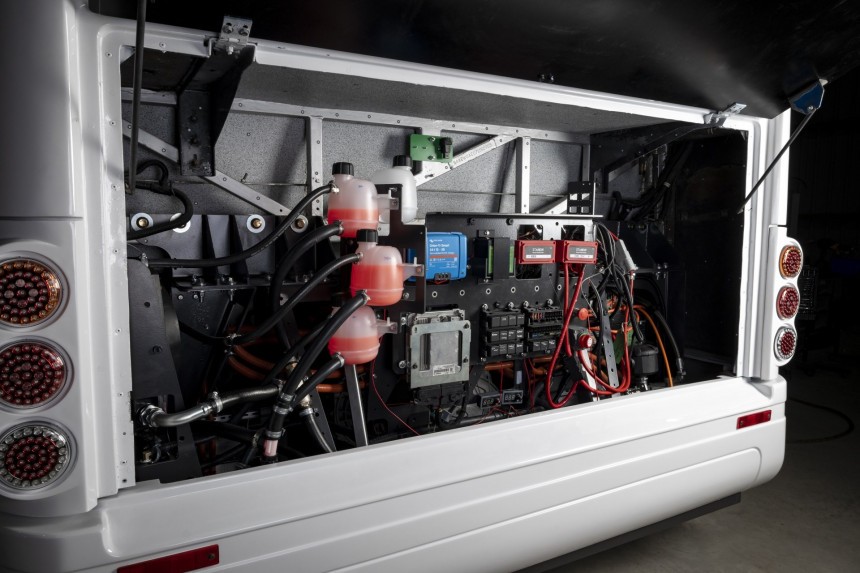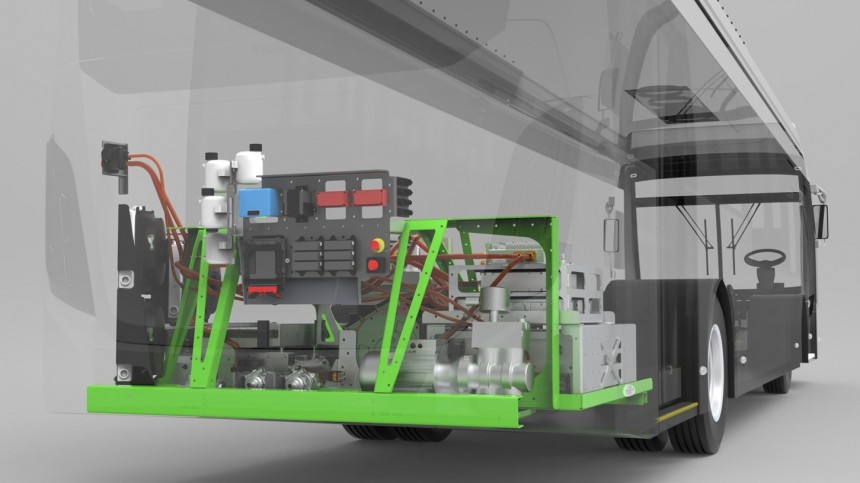Just a few months ago, we wrote about a company that has developed a kit that can turn a conventional diesel bus into an electric one. Now, the firm has presented one of its finished conversions in the form of a prototype, and they say it is just the beginning.
The firm in question is called Kleanbus, and it is now going through a prototype testing phase, which involves bus fleet operators to learn if they need to change things or reconfigure their process or the resulting vehicles in any way to make the most out of the conversion.
The biggest reason for any fleet operator to convert is the fact that a repowered bus is significantly less expensive than a brand-new, all-electric bus, as well as the fact that these will have just one-third of the operating costs of a diesel bus. Another benefit is the fact that it extends the life of a functional bus chassis while reducing the need to recycle one.
Moreover, converting an older bus from diesel to electric power also means one less diesel bus driving through the center of a city. Ideally, a bus operator that is a public transit company will time these conversions when their older buses require costly engine repairs, which are a reality even though they are not subjected to high loads during their work.
The solution proposed by Kleanbus involves an "e-drivetrain in a box," which effectively replaces the old diesel engine in a bus, regardless of the size or height of the bus, and charging is not an issue since it can be done at the bus depot, where many conventional vehicles spend hours each day.
Yes, not even conventional diesel-powered buses do not get driven round-the-clock, even with driver changes, so the EV ones would fit right in.
This kind of conversion is not suitable for extreme environments such as Oymyakon, where vehicles are kept running to prevent them from freezing over, but that is just an extreme use case scenario that does not apply to 99 percent of the buses being made.
The biggest advantage of an electric bus for public transportation is the fact that all its routes are predetermined, and its mileage is easy to predict daily.
In theory, there should be no range anxiety because the charge can be topped off at the depot during the driver's break, and the route never changes, so it makes sense even from a practical standpoint.
The only issue is to have enough electrical energy available to charge all or most of the buses on the fleet overnight, which may be an issue without any upgrades to a city's power grid.
Fortunately, public transportation authorities do not decide to change their buses to EVs overnight, and authorities typically work together on these changes to adapt everything according to what will be the new normal.
Kleanbus needs two weeks to repower an existing bus to its new form, and that is a quicker delivery time than for a new electric bus. Once a particular bus type is adapted to electric power, it will be homologated to its new configuration, and that homologation document will be applied to future conversions of that bus type. In other words, this is cost-effective, as well, and it will become a more straightforward process in a few years.
The cost of such a conversion has not been mentioned with real-life figures, but that will be done soon once the prototype finishes its real-world testing procedure. Once a few customers order dedicated conversions, the price for such a conversion will be easier to estimate.
While cheaper than getting a new bus altogether, albeit an EV one, some costs will take miles and miles of driving without using conventional fuel until the conversion pays for itself.
Until the costs get amortized, they need to be paid, and this needs to be done without crippling the budget of the public transit authority, as well as without raising ticket prices to the moon.
Yes, the number of tickets sold is also an important variable here, as some bus lines are more profitable than others, and EV buses might be better on lines where there are fewer tickets sold than those that are always full.
On the other hand, you want to get pollution from diesel buses out of the city as soon as possible, and taking the old buses out of the center of a city is usually a priority. It will be up to each city's public transit authority, in particular, to determine which bus is the best for it, but we remind everyone that decisions like these are typically made based on purchase costs, as well as usage costs.
While an EV is cheaper to use in the long run, acquiring it is more expensive. The goal of both EV conversion firms and electric bus manufacturers is to reduce that initial cost to enable more acquisitions.
The folks over at Kleanbus pride themselves on being able to adjust their projects depending on the requirements of the customer.
Moreover, they have also partnered with several financing firms to enable a multitude of payment options, including battery leasing, which makes the most sense for some fleets. With all this happening in the field, it may bring a new direction to the industry instead of simply manufacturing and selling conventional buses.
The biggest reason for any fleet operator to convert is the fact that a repowered bus is significantly less expensive than a brand-new, all-electric bus, as well as the fact that these will have just one-third of the operating costs of a diesel bus. Another benefit is the fact that it extends the life of a functional bus chassis while reducing the need to recycle one.
Moreover, converting an older bus from diesel to electric power also means one less diesel bus driving through the center of a city. Ideally, a bus operator that is a public transit company will time these conversions when their older buses require costly engine repairs, which are a reality even though they are not subjected to high loads during their work.
The solution proposed by Kleanbus involves an "e-drivetrain in a box," which effectively replaces the old diesel engine in a bus, regardless of the size or height of the bus, and charging is not an issue since it can be done at the bus depot, where many conventional vehicles spend hours each day.
This kind of conversion is not suitable for extreme environments such as Oymyakon, where vehicles are kept running to prevent them from freezing over, but that is just an extreme use case scenario that does not apply to 99 percent of the buses being made.
The biggest advantage of an electric bus for public transportation is the fact that all its routes are predetermined, and its mileage is easy to predict daily.
In theory, there should be no range anxiety because the charge can be topped off at the depot during the driver's break, and the route never changes, so it makes sense even from a practical standpoint.
Fortunately, public transportation authorities do not decide to change their buses to EVs overnight, and authorities typically work together on these changes to adapt everything according to what will be the new normal.
Kleanbus needs two weeks to repower an existing bus to its new form, and that is a quicker delivery time than for a new electric bus. Once a particular bus type is adapted to electric power, it will be homologated to its new configuration, and that homologation document will be applied to future conversions of that bus type. In other words, this is cost-effective, as well, and it will become a more straightforward process in a few years.
The cost of such a conversion has not been mentioned with real-life figures, but that will be done soon once the prototype finishes its real-world testing procedure. Once a few customers order dedicated conversions, the price for such a conversion will be easier to estimate.
Until the costs get amortized, they need to be paid, and this needs to be done without crippling the budget of the public transit authority, as well as without raising ticket prices to the moon.
Yes, the number of tickets sold is also an important variable here, as some bus lines are more profitable than others, and EV buses might be better on lines where there are fewer tickets sold than those that are always full.
On the other hand, you want to get pollution from diesel buses out of the city as soon as possible, and taking the old buses out of the center of a city is usually a priority. It will be up to each city's public transit authority, in particular, to determine which bus is the best for it, but we remind everyone that decisions like these are typically made based on purchase costs, as well as usage costs.
The folks over at Kleanbus pride themselves on being able to adjust their projects depending on the requirements of the customer.
Moreover, they have also partnered with several financing firms to enable a multitude of payment options, including battery leasing, which makes the most sense for some fleets. With all this happening in the field, it may bring a new direction to the industry instead of simply manufacturing and selling conventional buses.
